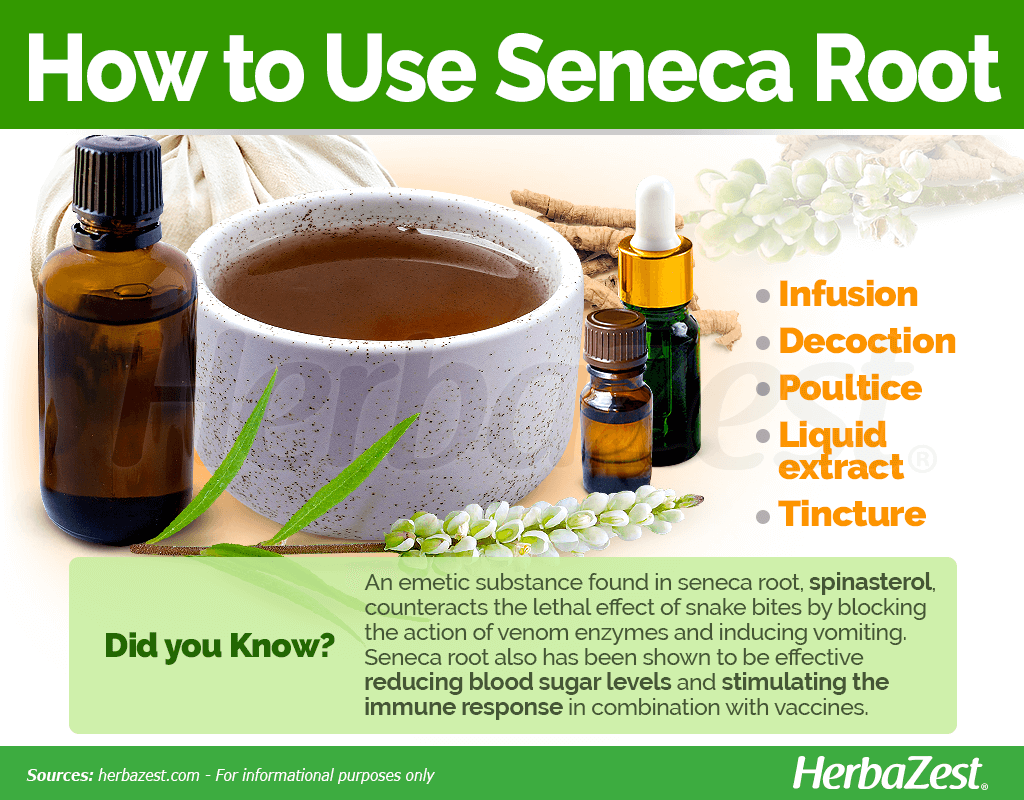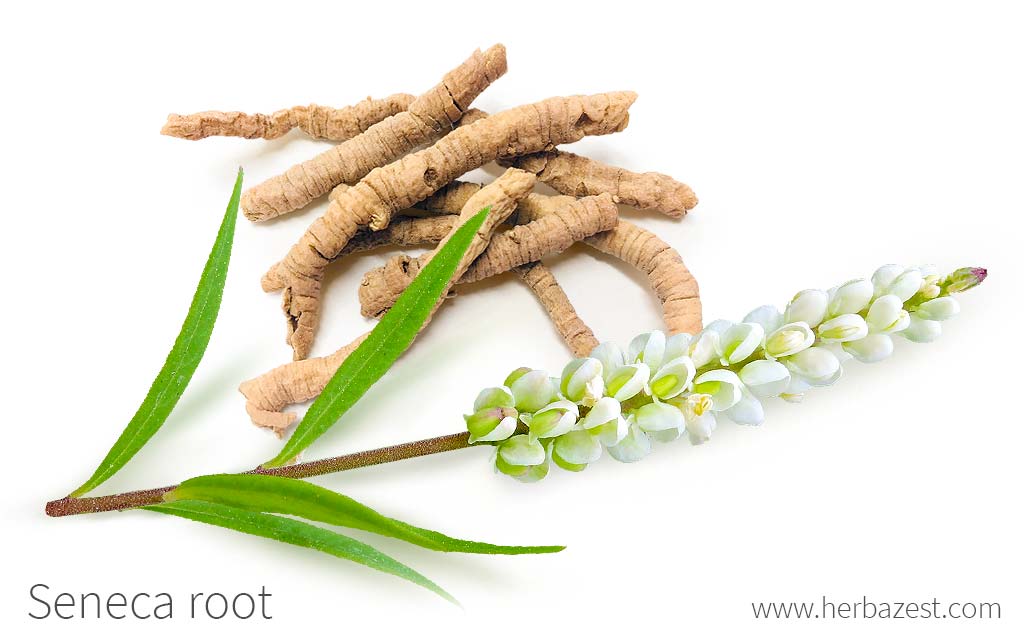Seneca root - also known as Seneca snakeroot, Senega snakeroot, Seneca milkwort, rattlesnake root, and mountain flax, among other names - is an herbaceous perennial hailing from southern Canada, as well as the eastern and central United States. Originally used as a remedy for snakebites, most medicinal applications of Seneca root have declined throughout the years.
Seneca Root Medicinal Properties
- Medicinal action Antitussive, Expectorant
- Key constituents Senegin, polygalic acid, salicylic acid
- Ways to use Decoctions, Hot infusions/tisanes, Tincture, Poultice
- Medicinal rating (1) Very minor uses
- Safety ranking Use with caution
Health Benefits of Seneca Root
Seneca root's expectorant, antitussive, and emetic properties have been traditionally used for:
Relieving respiratory problems. The expectorant properties of seneca root have been effective against chronic bronchitis, asthma, and emphysema, as well as for relieving cough, thanks to its antitussive activities.1
Additionally, scientific research has found potential medicinal applications for this Native American herb, such as:
Reducing blood sugar. The rhizomes of Seneca root have been shown to have a hypoglycemic effect, which may be beneficial for treating metabolic syndrome and diabetes.2
Stimulating the immune system. Seneca's active principles have proven effective in increasing specific immune responses when used in combination with vaccines.3
How It Works
The major constituents of seneca root are triterpenoid saponins, as well as phenols, methyl salicylate, and sterols.4
Two triterpenoid saponins, senegin and polygalic acid, are thought to be responsible for the expectorant properties of seneca root. These constituents produce local irritation of the mucous membranes of throat and respiratory tract, stimulating bronchial secretion.
On the other hand, seneca root also contains salicylic acid, which has anti-inflammatory and analgesic actions that are effectively used in a variety of over-the-counter medications to help reduce cough and throat inflammation.
An emetic substance found in seneca root, spinasterol, counteracts the lethal effect of a snake bite by blocking the action of venom enzymes. It causes gastrointestinal irritation, which induces vomiting and purging.
Other herbs that can help relieve cough and respiratory diseases are coltsfoot, eucalyptus, and myrtle.
Seneca Root Side Effects
The short-term use of the herb, at recommended doses, it is considered safe and has shown no serious side effects. However, long-term usage or overdose of Seneca root can cause stomach irritation, diarrhea, dizziness, nausea, and vomiting.
There is insufficient evidence proving the safety of using seneca root as a gargle or topical ointment. Those with sensitive skin should take appropriate precautions when testing the ointment.
Seneca Root Cautions
It is believed that Seneca root may cause uterine contractions and begin the menstruation process; therefore, pregnant women should avoid use of the herb altogether. There is no information on the use of the herb during lactation.
Moreover, those with fevers are recommended to avoid the herb, as it can affect the central nervous system. It is also thought that Seneca root irritates the intestines; those with gastrointestinal conditions should also avoid use.
The herb reportedly lowers blood sugar levels; those taking diabetes medication should avoid usage. People who are hypersensitive to aspirin or salicylates should not take Seneca root.

How to Consume Seneca Root
- Edible parts Root
Seneca root is not used in a culinary capacity. However, the herb has a long history of medicinal applications, mainly for treating a variety of respiratory ailments.
Natural Forms
Infusion. Seneca's dried root (0.5 - 1 g) is steeped in hot water for 10 - 15 minutes. This preparation can be taken three times daily for treating respiratory problems.
Decoction. Seneca root can be boiled to obtain a concentrated liquid that can be gargled for relief from sore throats and throat infections.
Poultice. A poultice of chewed Seneca root was traditionally used among Native Americans for topical relief of rattlesnake bites.
Herbal Remedies & Supplements
Liquid extract. This preparation is made by extracting the constituents of senega snakeroot in a non-alcoholic solution (e.g., water, glycerin, vinegar). It is commonly used for relieving respiratory illnesses.
Tincture. Seneca root tincture is obtained by macerating the plant in alcohol. It is traditionally used as an expectorant. The recommended dose is 1 - 2 mL, diluted in water, three times daily.

Growing
- Life cycle Perennial
- Harvested parts Roots
- Light requirements Full sun, Partial shade
- Soil Light (sandy), Medium (loam), Heavy clay
- Soil pH 6.1 – 6.5 (Slightly acidic)
- Growing habitat Temperate climates, Woodlands
- Pre-germination seed treatment Stratification
- Planting time Right after last frost
- Plant spacing average 0.4 m (1.31 ft)
- Propagation techniques Stem cuttings
- Potential insect pests Mites
- Potential diseases Leaf spot, Rust
Seneca root is mainly found in the wild in open woods, along roadsides, and in prairies. However, due to its pretty flowers and medicinal potential, it is and ideal plant to be grown in a home garden or backyard.
Growing Guidelines
In general, the herb prefers slightly alkaline soils that are nutrient-rich.
Seneca root also grows best in full sun to partial shade.
The propagation of Seneca root can be done through seeds or shoot cuttings.
Seeds need to be cold stratified for 60 days before planting in the spring.
Harvesting of the roots happens in the late summer or early fall. It takes four years for the plant to produce a usable root.
Additional Information
Plant Biology
Seneca root is composed of 15 - 20 smooth, slender, erect stems growing from one base. The herb grows 12 - 20 inches (30 - 50 cm) tall and is normally unbranched. The narrow, lance-shaped leaves are thin in texture and 1 - 2 inches (2.5 - 5.0 cm) long. Seneca root will begin to produce small, greenish-whitish flowers in May and June on the end of the stems. Lower flowers will develop before upper flowers open. The twisted, grayish-brown root, which is the part of the plant that's harvested, smells and tastes like wintergreen.
Classification
Seneca root, Polygala senega, is a flowering perennial that belongs to Polygalaceae, or the milkwort family, which is composed by annual, biennial, or perennial herbs characterized by their milky sap. The genus name, Polygala, comes from the Greek words poly, meaning "much" or "many," and gala, meaning "milk."
Seneca root derives its name from the "senega", or "seneca", the indigenous name of the North American tribe who used the herb as a cure for snakebites.
Related Species
Related American species of Polygala senega (Seneca root or snakeroot), better known as ornamentals rather than as medicinal herbs, are P. cruciata (cross-leaved milkwort), P. curtissii (Curti's milkwort), P. incarnata (pink milkwort), P. lutea (yellow milkwort), P. nuttallii (Nuttall's milkwort), P. paucifolia (fringed milkwort, birth-on-the-wing), P. sanguinea (field or rose milkwort), and P. verticillata (whorled milkwort).
Yuan zhi (P. tenuifolia), native to China and Japan, has similar constituents and is also taken to treat respiratory illnesses. This Asian Polygala species is most frequently encountered in supplements as a replacement for seneca snakeroot.
Historical Information
Seneca root has a rich history, as the plant first received its common name from the Seneca First Nation's use of it as a treatment for snakebites. Other First Nations utilized the root against respiratory problems, headaches, and stomachaches.
Come the 1700s, Seneca root's use for respiratory ailments reached Europe, where it was used for pneumonia. In the first half of the 1900s, the herb was used in over-the-counter patent medicines.
However, the use of Seneca root has been pushed out of popularity by newer drugs and antibiotics. Today, the herb is primarily used in herbal remedies and over-the-counter cough medication in Europe and East Asia.
Economic Data
Seneca root is officially recognized as a medicinal herb in the U.K. and Germany.
Until the early 1960s, Canada was the chief supplier of Seneca root, with the majority of exported roots collected from the wild in the provinces of Saskatchewan and Manitoba, which are still major suppliers for the Japanese, North American, and European markets.
Demand has been estimated at an annual growth rate of 5%, leading to overharvesting in the past years. Since collecting mature roots sacrifices the plant, cultivation is a potentially desirable alternative.
Popular Beliefs
Many popular beliefs surround Seneca snakeroot due to its wide use among Native American peoples. For example, the floral essence of the plant was popularly believed to stimulate old memories as well as reduce quarreling. The Cree and Chippewa peoples believed that the herb had the power to protect those on long journeys.
Other Uses
- Gardening. Seneca root is grown to a minor extent as an ornamental herb.
While Seneca root has fallen out of popularity in light of modern medicines, it holds an important place in the history of Native American herbalism. Nowadays, this herb is used on a small scale as both a medicinal plant and an ornamental.
Sources
- American Herbal Products Association's Botanical Safety Handbook, Second Edition, p. 689
- Canadian Medicinal Crops, pp. 124-125
- Coalition of Canadian Healthcare Museums and Archives, Seneca-snakeroot (Polygala senega)
- Flora of Wisconsin, Polygala senega L.
- Government of Canada, Manitoba, Senega Snakeroot
- Manitoba Government, Senega Snakeroot
- Medicinal Plants, Culture, Utilization and Phytopharmacology
- Phytomedicines, Herbal Drugs, and Poisons, p. 224
- Purdue University, Seneca-Snakeroot
- Spring Wildflowers of the Northeast: A Natural History, p. 91
- The Plants of Pennsylvania: An Illustrated Manual, pp. 567-568
Footnotes:
- Indian Journal of Research in Homoeopathy. (2021). Pharmacognostic studies of Polygala senega L. Root: A homoeopathic drug. Retrieved April 19, 2024, from: Retrieved April 19, 2024, from: https://www.ijrh.org/cgi/viewcontent.cgi?article=1488&context=journal
- Planta Medica. (1996). Hypoglycemic effect of the rhizomes of Polygala senega in normal and diabetic mice and its main component, the triterpenoid glycoside senegin-II. Retrieved April 19, 2024, from: https://pubmed.ncbi.nlm.nih.gov/8923811/
- Comparative Immunology, Microbiology and Infectious Diseases. (2000). Isolation and evaluation of immunological adjuvant activities of saponins from Polygala senega L. Retrieved April 19, 2024, from: https://pubmed.ncbi.nlm.nih.gov/10660256/
- International Journal of Pharmacy & Life Sciences. (2015). Ethnopharmacological attributes of Polygala senega Linn. Retrieved April 19, 2024, from: http://www.ijplsjournal.com/issues%20PDF%20files/2015/January-2015/11.pdf





